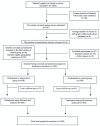Effectiveness of a Randomized Controlled Lifestyle Intervention to Prevent Obesity among Chinese Primary School Students: CLICK-Obesity Study
- PMID: 26510135
- PMCID: PMC4625022
- DOI: 10.1371/journal.pone.0141421
Effectiveness of a Randomized Controlled Lifestyle Intervention to Prevent Obesity among Chinese Primary School Students: CLICK-Obesity Study
Abstract
Background: Childhood obesity has been increasing rapidly worldwide. There is limited evidence for effective lifestyle interventions to prevent childhood obesity worldwide, especially in developing countries like China. The objective of this study was to assess the effectiveness of a school-based multi-component lifestyle childhood obesity prevention program (the CLICK-Obesity study) in Mainland China.
Methods: A cluster randomized controlled trial was developed among grade 4 students from 8 urban primary schools (638 students in intervention, 544 as control) in Nanjing City, China. Students were randomly allocated to the control or intervention group at school-level. A one-year multi-component intervention program (classroom curriculum, school environment support, family involvement and fun programs/events) together with routine health education was provided to the intervention group, while the control group received routine health education only. The main outcome variables assessed were changes in body mass index, obesity occurrence, obesity-related lifestyle behaviors and knowledge.
Results: Overall, 1108 (93.7%) of the 1182 enrolled students completed the intervention study. The intervention group had a larger marginal reduction than did the control group in overall mean BMI value (-0.32±1.36 vs. -0.29±1.40, p = 0.09), although this was not significant. Compared with the control group, the intervention group was more likely to decrease their BMI (OR = 1.44, 95%CI = 1.10, 1.87) by 0.5 kg/m2 or above, increase the frequency of jogging/running (OR = 1.55, 95%CI = 1.18, 2.02), decrease the frequency of TV/computer use (OR = 1.41, 95%CI = 1.09, 1.84) and of red meat consumption (OR = 1.50, 95%CI = 1.15, 1.95), change commuting mode to/from school from sedentary to active mode (OR = 2.24, 95%CI = 1.47, 3.40), and be aware of the harm of selected obesity risk factors.
Conclusions: The school-based lifestyle intervention program was practical and effective in improving health behaviors and obesity-related knowledge for children in China. This study provides important policy implications on school-based intervention programs for modifications of obesity-related lifestyles.
Trial registration: Chinese Clinical Trial Registry ChiCTR-ERC-11001819.
Conflict of interest statement
Figures
References
-
- World Health Organization (2013) Global Strategy on Diet, Physical Activity and Health. Childhood overweight and obesity. Available: http://www.who.int/dietphysicalactivity/childhood/en/. Accessed 2013 Aug 10.
-
- Pigeot I, Barba G, Chadjigeorgiou C, de Henauw S, Kourides Y, Lissner L, et al. (2009) Prevalence and determinants of childhood overweight and obesity in European countries: pooled analysis of the existing surveys within the IDEFICS Consortium. Int J Obes (Lond) 33 (10): 1103–10. - PubMed
Publication types
MeSH terms
Associated data
Grants and funding
LinkOut - more resources
Full Text Sources
Other Literature Sources
Medical


